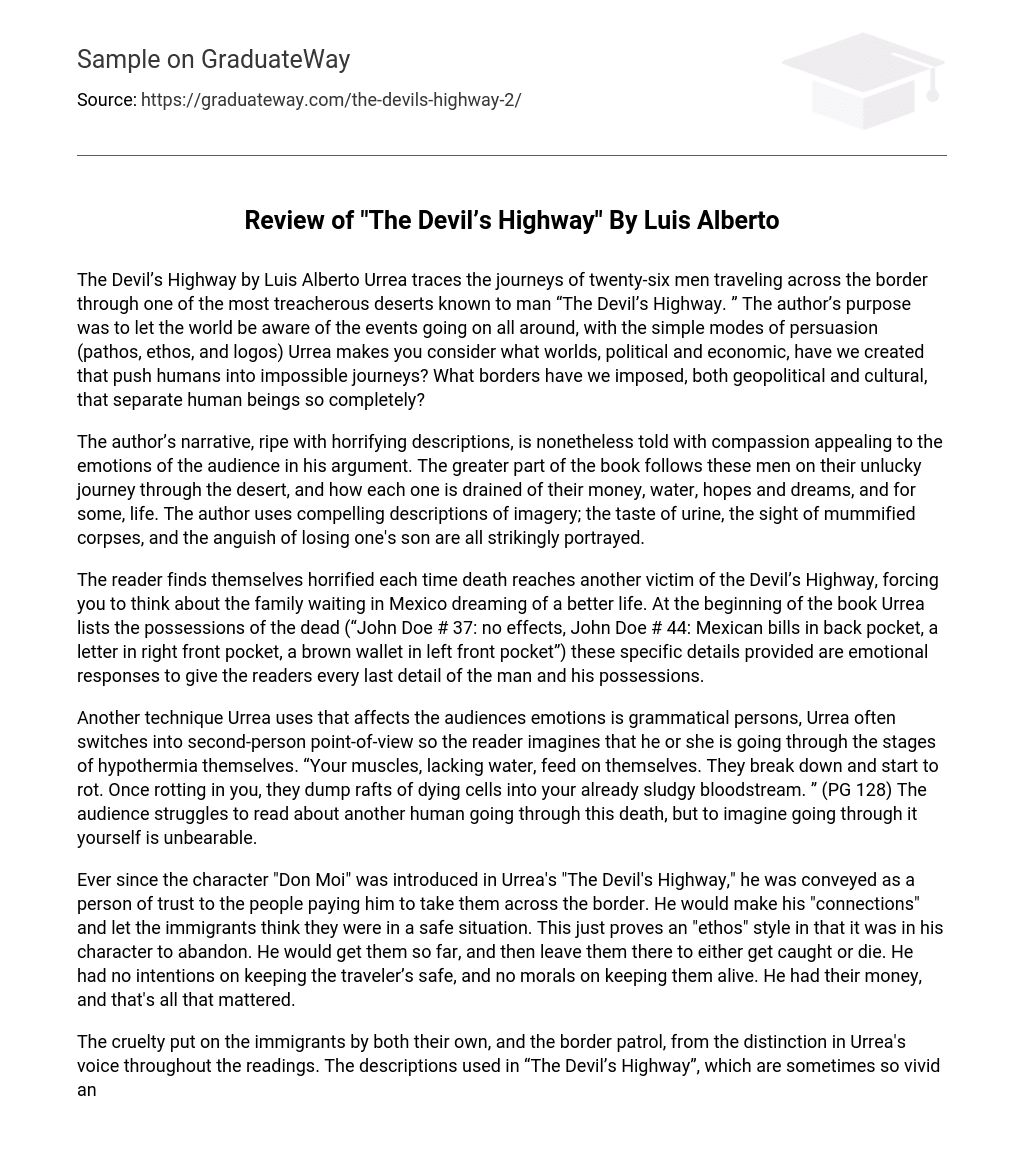The Devil’s Highway by Luis Alberto Urrea traces the journeys of twenty-six men traveling across the border through one of the most treacherous deserts known to man “The Devil’s Highway. ” The author’s purpose was to let the world be aware of the events going on all around, with the simple modes of persuasion (pathos, ethos, and logos) Urrea makes you consider what worlds, political and economic, have we created that push humans into impossible journeys? What borders have we imposed, both geopolitical and cultural, that separate human beings so completely?
The author’s narrative, ripe with horrifying descriptions, is nonetheless told with compassion appealing to the emotions of the audience in his argument. The greater part of the book follows these men on their unlucky journey through the desert, and how each one is drained of their money, water, hopes and dreams, and for some, life. The author uses compelling descriptions of imagery; the taste of urine, the sight of mummified corpses, and the anguish of losing one’s son are all strikingly portrayed.
The reader finds themselves horrified each time death reaches another victim of the Devil’s Highway, forcing you to think about the family waiting in Mexico dreaming of a better life. At the beginning of the book Urrea lists the possessions of the dead (“John Doe # 37: no effects, John Doe # 44: Mexican bills in back pocket, a letter in right front pocket, a brown wallet in left front pocket”) these specific details provided are emotional responses to give the readers every last detail of the man and his possessions.
Another technique Urrea uses that affects the audiences emotions is grammatical persons, Urrea often switches into second-person point-of-view so the reader imagines that he or she is going through the stages of hypothermia themselves. “Your muscles, lacking water, feed on themselves. They break down and start to rot. Once rotting in you, they dump rafts of dying cells into your already sludgy bloodstream. ” (PG 128) The audience struggles to read about another human going through this death, but to imagine going through it yourself is unbearable.
Ever since the character “Don Moi” was introduced in Urrea’s “The Devil’s Highway,” he was conveyed as a person of trust to the people paying him to take them across the border. He would make his “connections” and let the immigrants think they were in a safe situation. This just proves an “ethos” style in that it was in his character to abandon. He would get them so far, and then leave them there to either get caught or die. He had no intentions on keeping the traveler’s safe, and no morals on keeping them alive. He had their money, and that’s all that mattered.
The cruelty put on the immigrants by both their own, and the border patrol, from the distinction in Urrea’s voice throughout the readings. The descriptions used in “The Devil’s Highway”, which are sometimes so vivid and dramatic that reader is left wondering whether he may have been a walker in a past life, leave few details missing. The logos used in this book are through politics. Urrea makes clear that it’s Mexico’s blame for putting people on the “devil’s highway” through corruption and dense politics. But he also shows how misguided the United States policy has been.
The author describes the conditions and historic events that lead to the beginning of the illegal immigration into the United States and draws a clear parallelism with our times, when there are several tasks in the United States that Americans are reluctant to do, thus illegal immigrants are needed for this. Urrea discusses the political and economic side of crossing the border without giving blame leaving the main question up to the reader. In the final analysis, it becomes obvious that every person involved in the tragedy is exactly that – a human being. If anyone is to blame for the tragedy, we are all to blame.
It is in that sense that the ultimate finger of blame has to eventually point at the United States and Mexican governments. Their efforts to end the dilemma could be considered ridiculous, if not so disastrous: from the Mexican side there are signs telling walkers not to walk, and on the U. S. side there are preventive walls and fences that discourage them from crossing where it might actually be safe to do so. In order to make the passage, the immigrants are forced to traverse a hostile desert. Yet, as Urrea so successfully demonstrates, the two countries are in truth extraordinarily codependent.





